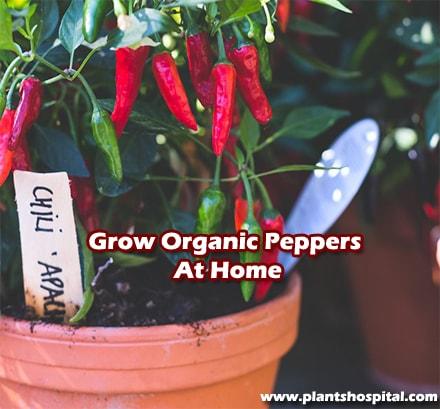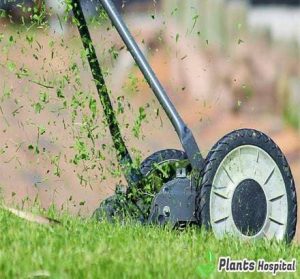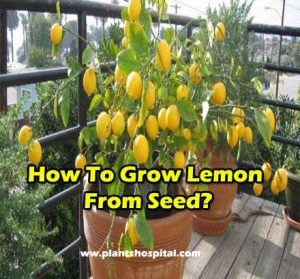Let’s all answer the question of how to grow peppers at home. Wondering how to grow peppers in your favorite pot or on a balcony? Here are the golden rules you need to know for growing peppers!
Table of Contents
How To Growing Organic Pepper?
Organic farming is the new trend of recent years among the secrets of healthy living. This list of Secrets also includes grow peppers at home. It is now up to you to grow all-natural peppers without drugs and hormones.
In the home environment, pepper growing in the pot has also been one of the most frequently tried hobbies of today. If you love to work with soil and enjoy producing something new, this article on growing peppers at home will be your companion!
Red pepper, yellow pepper, green pepper, ornamental pepper, various types of peppers adorn the tables in all forms. Both salads and meals when it is included in the smell and flavor of appetites opens.
It is easier to grow these types of peppers at home than you think! We will now give you the information you need to grow peppers at home. This page contains the tricks of growing pepper in a pot. When you browse the entire page, you will notice that you will easily grow organic peppers at home. The peppers from the pot to your table will be both manual and 100% natural!
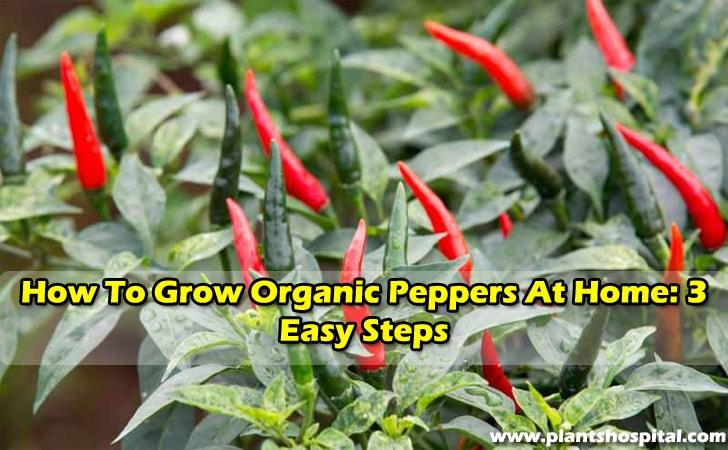
Ingredients Required To Grow Peppers At Home
You should prepare all the necessary ingredients before growing peppers in the home environment. Now review the list and assemble the equipment you need on the balcony!
- Pepper seed.
- Plastic cups.
- Wide and deep light-colored pot.
- Mineral-rich soil.
- Spray bottle and water.
Watch Video: How to Grow Organic Peppers at Home?
How to Grow Organic Peppers at Home? 3 Easy Steps with Illustrations
Step 1
• To grow the most delicious peppers at home, you must first germinate the seeds. You may prefer the spring months to germinate the seeds.
• April is the ideal time for you.
• First, soil is added into the plastic cup to germinate the seeds.
• Press the soil with your hands to make it lightly compacted.
• Place 3 pepper seeds in the middle of the soil and sprinkle the soil over the seeds.
• Moisten the soil several times with the water you add into the spray bottle and cover the mouth of the glass with stretch film.
• Keep this plastic cup in the house and at room temperature for 5 days.
• The glass should be ventilated for a few minutes each morning.
• The seeds will germinate at the end of the last 5 days. Now we can move on to the next step.
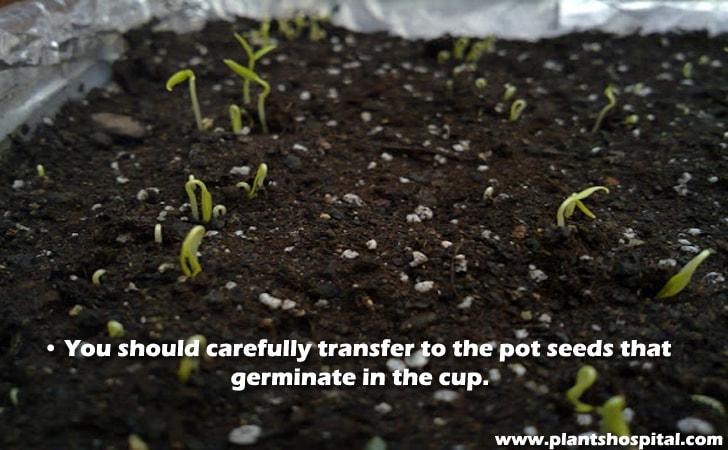
Step 2
• You should carefully transfer to the pot seeds that germinate in the cup.
• You can cut the plastic cup to transfer to the pot.
• Now fill half of the flower pot with threshing soil.
• Take the peppers that you germinate right in the middle of the soil. For this, add all the soil in the cup to the pot.
• Add enough new soil to cover the environment of the germinating plant and note that there is an equal amount of soil in the pot.
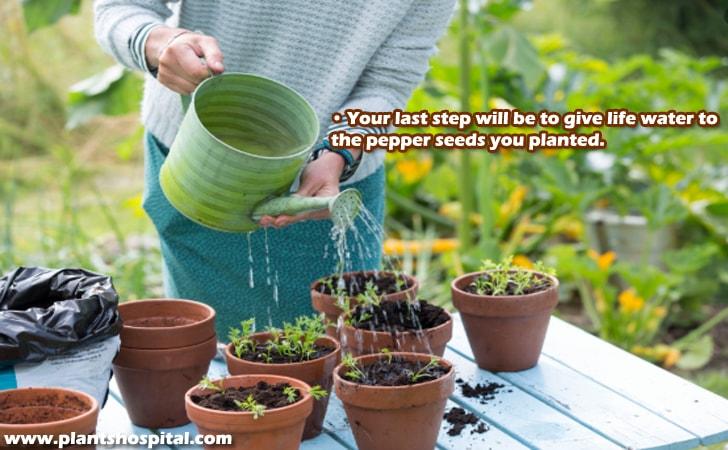
Step 3
• Your last step will be to give life water to the pepper seeds you planted.
• You should water the seeds that have gained a new soil and pot, do not leave too watery. You can use the spray again for this.
• Pepper planting consists of such simple operations.
• Now it is up to you to be patient and take care of the pepper seedling!
How to Care for Peppers? (6 Steps)
Positioning
• Pepper is a sun-loving plant and wants to make use of the sun all day long.
• You can position the pepper pot in your home or on a balcony overlooking the sun.
• The development of seedlings is slowed down when it is in the shade or when gets wind.
• Pepper likes warm and warm climates, can not withstand harsh winters. Therefore, the room temperature should be maintained.
- 4 Steps With Picture: How To Grow Potatoes In The Bag & At Home
- How To Grow Ginger In A Pot At Home In 5 Easy Steps: Planting & Care
Watering
• Pepper seedlings that love water very much love to stay moist. It is therefore recommended that you check your soil every morning.
• It is right to meet the water requirement of the plant without leaving the pot watery.
• You can easily water pepper seedlings with the help of spray.
• When you think that you have given a lot of water to the pot, you need to decontaminate irrigation for 1 day. Too much added water causes the soil to become insectivorous.
Read More: Dehydration: 6 Things that can Cause Dehydration (Watering Plant)
Fertilization
• Fertilizer is important for every plant and pepper wants to be fertilized.
• It is recommended to fertilize the pot at regular intervals because the fertilizers will lose their effect over time when you water the peppers.
• 2 tablespoons of fertilizer for each pot, period will benefit the plant nutrition.
Pruning
• As the seedling grows, it starts to give leaves. For the roots of the plant to receive the sun comfortably, the leaves must also be cleaned.
• Pruning period is completely determined according to the condition of the leaves. If you have dry or rotting leaves, it is recommended to clean them.
• Dried leaves can tire the whole plant. In this case, you can take precautions with pruning.
Soil Selection
• You can change the soil of the pepper pot after each harvest.
• In the summer period, the soil will lose more than the nutritional value of the plant can continue to grow by renewing the soil every year.
• The soil you choose should be rich in minerals and fertilized.
• If you change the soil every year, you will prevent the insects from the plant.
• If the pH of the soil for Peppers is between 6 – 6.5, the plant can continue development in the best way.
Harvest Time
• Pepper seeds begin to produce in the summer. All peppers should be collected before October.
• If you planted peppers in a large pot, you should check and collect the peppers under a leaf.
• Take care not to damage other peppers while plucking peppers.
- 9 Easy Ways to Grow Watermelons: Watering & Planting (Step to Step)
- 10 Easy Ways To Grow Bananas At Home: 5 Steps with Pictures
7 Tricks To Help You Grow Peppers
1) In the above statements, we have indicated that you should choose the flower pot in light colors.
2) Let’s make an explanation for those who say should be a light-colored pot. If you choose a dark-colored pot, the pepper will take a lot of sun and cause it to burn in roots.
3) Burning of roots causes to die pepper. If you choose a light-colored pot, it gets the sun more healthy and protects the plant’s yield.
4) Never leave the soil dry as pepper loves water! You have to check daily!
5) When your plant starts to produce, sagging may occur in its branches depending on the size of the peppers. You can use the support rods to prevent these sagging and support the plant.
6) If your soil mixture consists of garden soil, peat and fertilizer, you can harvest a large amount of pepper.
7) Pepper seedlings will occur to protect the plants for insects that can get drugs. These drugs will destroy the insects without damaging the pepper.
7 Great Reasons To Consume More Pepper!
Grow peppers at home is both an economical and enjoyable endeavor. So why should pepper be consumed? We have prepared a list to remind you of the effects of pepper on your health. Here are the benefits of pepper!
1) The structure of the cayenne pepper contains the substance capsaicin. This substance is also effective in the active metabolism. It also helps to regenerate the body.
2) Pepper supports cell regeneration and allows your body to continuously produce new cells. This feature makes you feel younger.
3) Pepper, which is rich in Vitamin value, also strengthens the immune system.
4) Pepper is a vegetable that opens the vocal cords. Because of gives the person energy and fitness, it can be consumed raw in meals during the day.
5) Pepper, which has a fibrous structure, also resolves constipation problem because of will relax the intestines.
6) You can strengthen the eyesight thanks to the pepper that protects eye health.
7) Pepper takes place in the list of antioxidant foods. This is a natural food source that can be used to prevent cancer.
Read Next: 4 Great Reasons To Grow Cucumbers At Home: Planting, Watering & More

